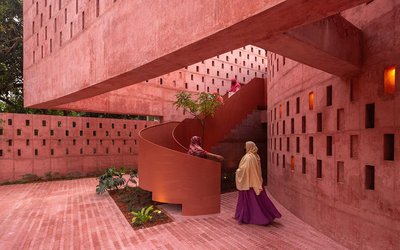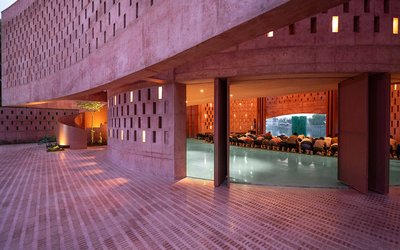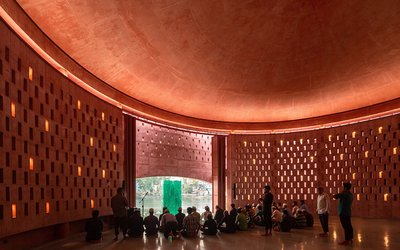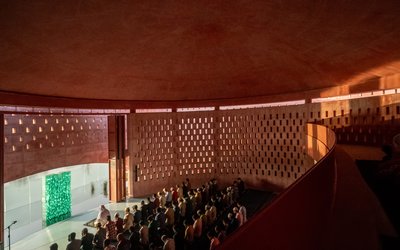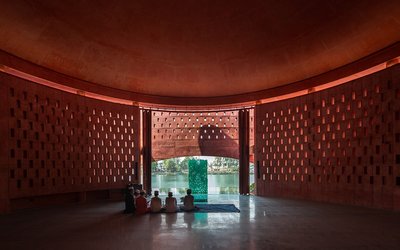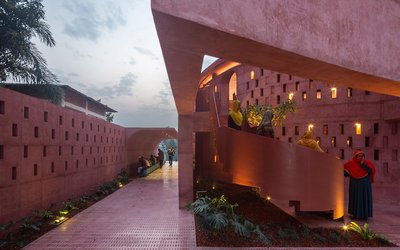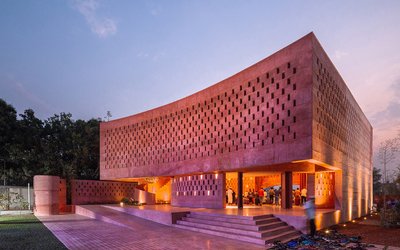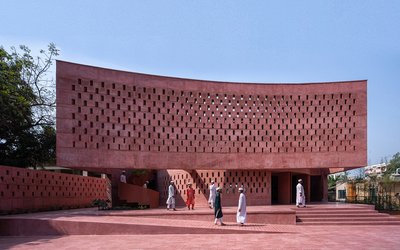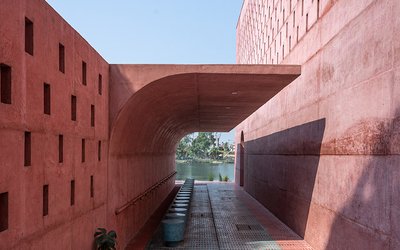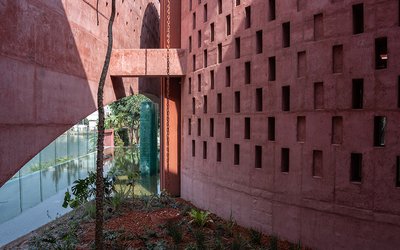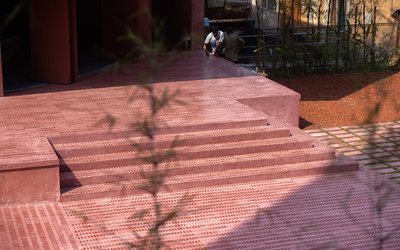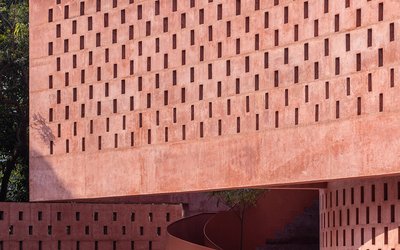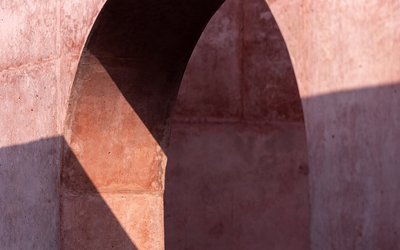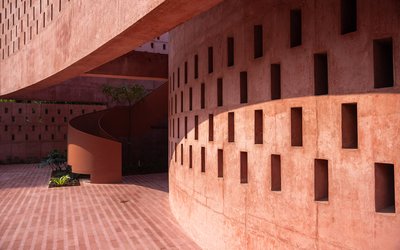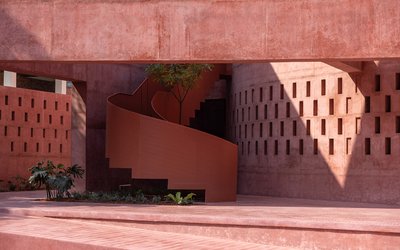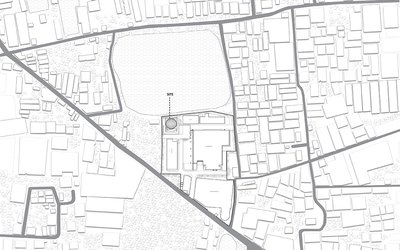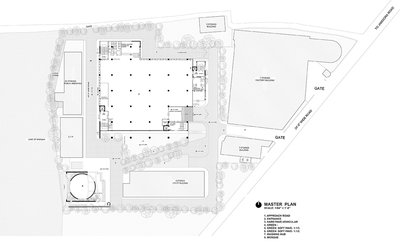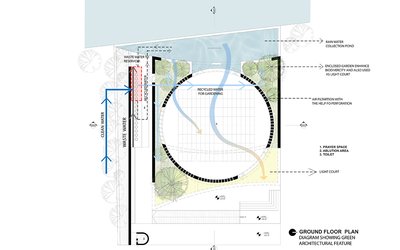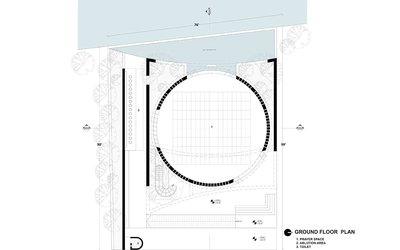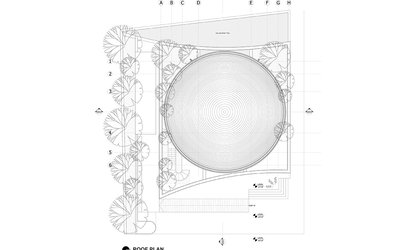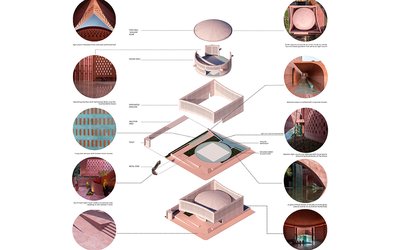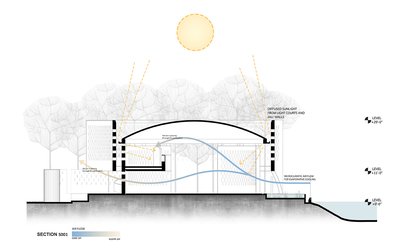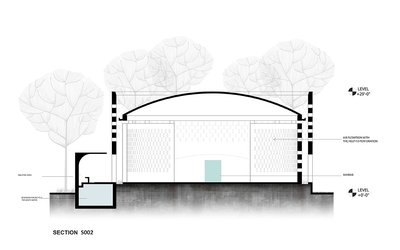Zebun Nessa Mosque
Ashulia, Bangladesh
A monolithic pink concrete mosque finds its location at the edge of an existing waterbody amidst a fast-growing industrial area at the outskirt of Dhaka City. The mosque is designed as a Permeable Pavilion that establishes deeper connection between water and land which serves as both as spiritual and breathing space within an industrial compound. The owner of the industry wanted to build a mosque for the workers to commemorate the memory of his late mother in the hope of inducing softness within the harsh industrial area. This narrative inspires the architect to design the mosque as a spiritual-social space enhancing mutual care and trust between owner and the workers.
The mosque incorporates elements that allow for filtered natural light and ventilation, creating a “breathing pavilion”. The mosque features a simple yet effective design, with a monolithic mass situated on a high plinth, reminiscent of the vernacular house forms built on ‘Bhiti’ (mound) in the deltaic landform of Bangladesh. The plan of the mosque evolves from simple geometric shapes, with a square surrounding a circular volume to create four enclosed gardens that serve as light courts on each side. The outer square volume melts into subtle curves in the east and west directions to interact with the site forces. The north-east hanging corner of the curve wall defines the main entry, facing the existing node of the two main internal roads of the industrial compound. The thick concrete walls are perforated with small rectangular voids. Filtered light seeping through the voids resembles hanging lanterns of old mosques.
The double layered thick walls create a microclimatic atmosphere within the mosque ensuring thermal comfort. Sunlight plays inside the garden-courts along the ‘jaali’ openings and reflects into the interior spaces while the heat dissipates out from interior. Being in a hot and humid climate the mosque is designed and encouraged to be a true naturally ventilated space devoid of any artificial air conditioning. Cool breeze passes through all openings coming from the outside natural waterbody that flows across the sequence of constructed water-pool to the interior prayer hall to outdoor elevated plinth surface. The doors and other thresholds are all made with perforated metal sheets to ensure filtered flow of wind during the heavy monsoon. All these features establish the very idea of a ‘breathing pavilion’, a deeply rooted architecture form of this tropical climate.
Mono-materiality is expressed through the exposed pigmented concrete structure. The warm hue of the rusted pink concrete form has a cooler turquoise hued mosaic floor. The outside broken brick mosaic work is an innovative take on the age old terrazzo and mosaic flooring where broken brick pieces are used instead of marble pieces. Addition of broken bricks on the traditional terrazzo flooring adds an excellent friction for the exterior floors surfaces. With its perforated as-cast pigmented concrete surface and uniquely crafted terrazzo floors, this handcrafted mosque promotes local craftsmanship which is becoming extinct due to the market pressure of using readymade imported building materials. 35-40% of the shuttering material is reused from the old shuttering material that were used during the construction of the adjacent washing hub building.
A shallow thin shell dome levitates over the perforated curve walls, elevating the singular interiority of the prayer hall. Use of the shallow dome comes as the most efficient means of covering a large span in terms of cost effectiveness and material optimization. The floating dome evokes the structural ingenuity of covering large space without intermediate supports manifested through chronological development of mosque architecture in the Islamic world.
Unlike solid qibla walls in conventional mosques the qibla of this mosque is defined by a wide arched opening on the subtle curved western wall. A reflective waterbody connects the turquoise mosaic interior through the arched opening to the existing pond, allowing the prayer space to flow seamlessly towards a light-filled infinity. The mosque is devoid of any glass surface except for the translucent glass mihrab which is placed on the shallow water body. The glass mihrab is uniquely hand crafted on site using local glass pieces.
The south-east courtyard of the mosque holds a perforated metal stair connecting to the crescent shaped upper floor preserved for female workers of the industrial complex. The space serves both as a meeting and prayer space for the women. A 'Chhatim' tree is planted near the stair to make the space filled with fragrance at the time of full bloom. Participating in the mosque activities caters a sense of empowerment and belongingness within the female workers of the industry.
The ablution area is designed to induce a sense of spirituality during the act of purification before performing the prayer. The rustic pink mosaic floor becomes turquoise representing tranquility. The turquoise and pink mosaic with carefully laid broken brick pieces reflects the mastery of age-old craftsmanship where the use of these colors connects with the collective memories of the users. The used ablution water is recycled and reused for watering the gardens.
The very concept of designing it both as a prayer space and a social space for community gathering is remarkable. The owner of the industry wanted to build a mosque for the workers to commemorate the memory of his late mother in the hope of inducing softness within the harsh industrial area enhancing mutual care and trust between owner and the workers. A significant focus was to engage the women workers into the religious and social activities of the mosque by providing designed space for them.
The planning constraints was to design the mosque within a confined leftover space of an industrial compound, surrounded by existing ETP plant, washing hub, garment and utility buildings and numerous scattered ducts and pits. It was very challenging to maintain construction flow within a running factory zone which also got interrupted during the covid lockdown. The whole team comprising the owner, architects, construction team and craftsmen efficiently orchestrated the whole process.
Mono-materiality is expressed through the exposed pigmented concrete structure. The power of traditional craftsmanship is expressed anew with customized use of locally available materials.
The interior atmosphere remains cooler than exterior temperature as gentle breeze passes through double layered perforated walls, shallow water body, shaded light courts and gardens adorned with fragrant flowering plants. The mosque celebrates the seasonal attributes of the tropical climate. The mosque's architecture promotes natural ventilation and employs recycled water for the gardens – embodying the vision for a space that respects and enhances its natural surroundings.
The design approach to this mosque, integrating sustainable practices, engaging the community, and balancing the modern with the traditional, showcases the owner’s and architect’s commitment to architecture that serves people, respects nature, and enriches the spirit. The mosque not only offers a serene oasis for the workers of Ashulia but also stands as an inspiring example of how architecture can foster a sense of belonging, care, and spiritual well-being in even the most unexpected places.




